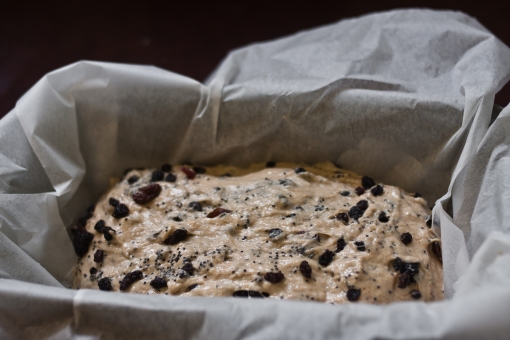I have a thing for baking bread. Sourdough bread, specifically. There’s a few reasons for this – the main one is that I really like eating it. Also, though, I enjoy the actual process of sourdough making, of nurturing the starter culture, throwing the wet dough around, and watching the magic that happens as the gluten and yeasts activate and the bread structure starts changing from a sodden lump of flour to a shiny, elastic, fragrant dough. I love the nuances of flavour that happen depending on how long I let it rise, and when I last fed the starter, and what flours I’ve used as starter-food. I’m very grateful for the robustness of sourdough bugs, too – they’ll happily adjust to a sunny summer bench, or a fridge, and if you happen to need to shove your dough in the fridge overnight instead of baking it when you should, they’ll happily just slow down their activity, rather than deflating into a limp and gassy lump, like standard yeasts. And they can live in containers in my fridge, getting fed once every week or so, without complaint. How cool is that!
As well, I love the fact that each person’s culture will be subtly different. The starter changes based on the native bugs in the air around us, the bugs in the original culture, and the bugs in the flour that they’re fed on (which is one of the reasons I almost always use organic flours in breadmaking). The idea that my bread is truly local bread, shaped by the environment it came from, is just wonderful. True Inner West bread!
Of course, I’m not a very good baker, but I’m having a hell of a lot of fun practicing.
Earlier this week, I made a loaf of one of my favourite breads; a sourdough spelt fruit loaf with currants, dried cranberries, and a tonne of poppyseeds. It turned out remarkably tasty; soft, moist, chewy, and richly fruity, so I thought I’d share some process and pictures with you. Sadly, I can’t fit the actual bread onto the computer screen.
This even counts as a Feedbag bread, if only just – there’s freshly-ground cinnamon from this fortnight’s feedbag in it. Not enough to overpower the bread, just enough for a subtle depth of spice.
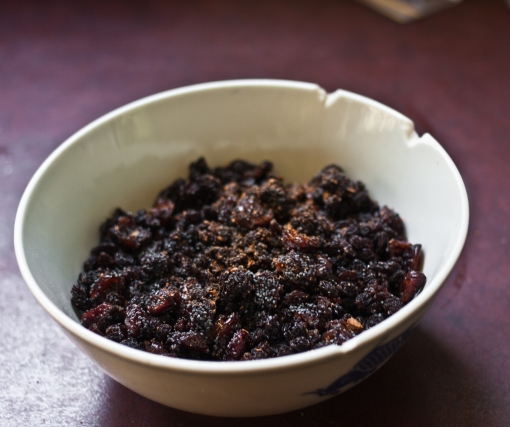
Currants, cranberries and cinnamon (with lots and lots of poppy seeds), ready to be kneaded into the dough
The fruit actually goes into the bread with the last knead, so it got to sit around in the bowl for a while, while the mixing and resting and dough-slapping went on.
Raw dough, when first mixed together, really looks like just a pile of sticky flour – most unappetising! After sitting for about 20 minutes, it gets its first kneading. Because sourdoughs usually contain much more water than standard bread doughs, you can’t use the traditional fold-push-turn method of kneading. Instead, most people throw the dough. Seriously! You scoop the dough up with one hand and a dough scraper, then slap it down hard onto the bench and stretch it slightly, before scooping it back up again, turning it, and throwing it around. It’s very therapeutic. Fortunately, because of the resting times, you don’t need to spend as long throwing it around as you would do with standard dough.
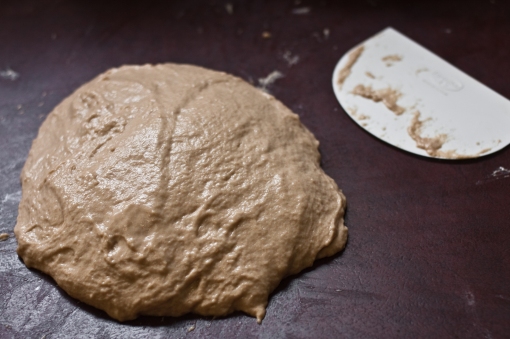
Just after the first knead, trusty dough scraper at the side
Once it’s been thrown around, it gets to sit in its bowl for about 20 minutes to get its breath back, then it’s time for another throwing session, until the dough is stretchy and elastic, and lightly glistening (like the picture above, except stretchier).
Then it’s time to rise – in the case of this fruit bread, it only gets one rise, in the pan it’ll be cooked in. Here it is, fruit and spices added, and settled into its bread tin:
And a few hours later, it had doubled in size, and was ready to go into the oven:
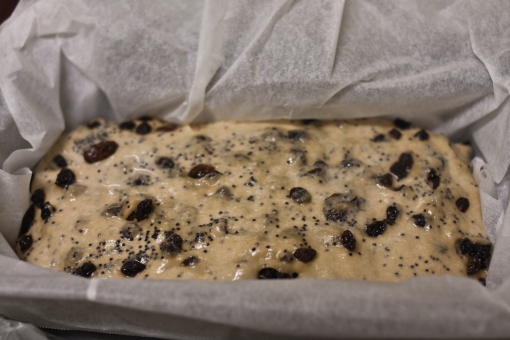
All grown up, and ready to bake
There’s a whole bunch of tricks you can use to bake sourdough well in a normal kitchen oven, but I’ll just share the most important one: don’t forget you’ve closed all your doors to keep heat in, and still expect to be able to smell when your bread is done.
The top got a bit over-browned, but as you can see, it was still delicious.
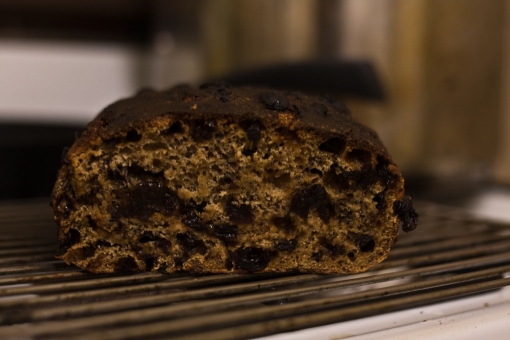
Out of the oven, and slightly cooled. Too brown on top, but very tasty!
I haven’t posted the recipe here, but if you want to make your own, comment and I can add it. And if you’re interested in some sourdough bugs for your very own, to love and cuddle and make tasty bread with, I can usually spare some, so let me know!
